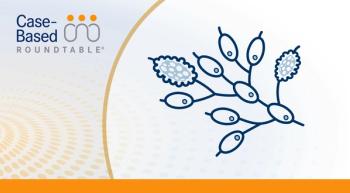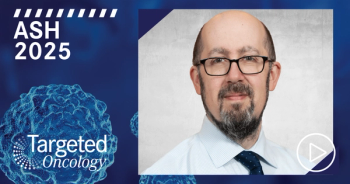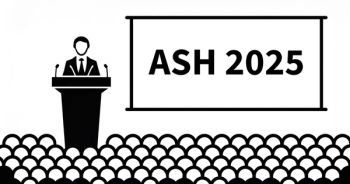
Peers & Perspectives in Oncology
- June 2023
- Volume 1
- Issue 1
- Pages: 13
Navigating CAR T-Cell Therapies in Relapsed/Refractory DLBCL
At a live, virtual event held in partnership with Healthcare Research & Analytics®, Alex F. Herrera Jr, MD, discussed the growing influence of chimeric antigen receptor T-cell therapies in patients with diffuse large B-cell lymphoma.
At a live, virtual event, Alex F. Herrera Jr, MD, of City of Hope Cancer Center, in Duarte, California, discussed the growing influence of chimeric antigen receptor (CAR) T-cell therapies axicabtagene ciloleucel (axi-cel; Yescarta), lisocabtagene maraleucel (liso-cel; Breyanzi), and tisagenlecleucel (tisa-cel; Kymriah), in patients with diffuse large B-cell lymphoma (DLBCL). At the event, he looked at the case of a 66-year-old patient with DLBCL who relapsed after 6 cycles of R-CHOP (rituximab [Rituxan], cyclophosphamide, doxorubicin, vincristine, prednisone) therapy.
Here he argues for the patient’s candidacy for CAR T-cell therapy and discusses the clinical data backing up this claim.
COMPARING CAR T-CELL CLINICAL DATA
It’s interesting that when you look at the results from the randomized trials evaluating CAR T cells in the second-line setting for patients with multiple myeloma], so ZUMA-7 [NCT03391466] and TRANSFORM [NCT03575351] in terms of axi-cel and liso-cel, respectively, the proportion of patients with durable response who received CAR T in the second line…is a similar proportion of patients.1,2
It’s about 30% to 40% of patients, whether patients are getting CAR T[-cell therapy] in the third line or later, or whether they get it in the second line. So for me, it’s less about the difference in efficacy between using CAR T-cell therapy earlier or later. If you can get the [patient] to CAR T-cell therapy, at least between the second and third lines or later, the rates of durable response seem similar. The longer you wait, the more resistant a patient’s disease is going to be and just generally the more aggressive, perhaps refractory they’re going to be too. Then it gets harder to get them through that period of getting a leukapheresis slot, collecting their cells, and having them able to wait during that production period.
Then when you just look at the randomized trials ZUMA-7 and TRANSFORM in the second-line setting, [it is] clearly for patients who are primary refractory or have early relapse where the disease comes back within a year of their frontline therapy. More than 90% of patients got CAR T, whereas less than half the patients got to stem cell transplant, and when you look at the progression-free survival [PFS] and event-free survival [EFS], which was the primary end point, it was clearly different between the groups.3
[Another trial to consider is the phase 3] BELINDA trial [NCT03570892], which evaluated tisa-cel.4 ZUMA-7 was initiated first, and the median follow-up was longer, at just over 2 years. Bridging therapy was not allowed, so it’s a bit of a cherry-picked population [in ZUMA-7].
In TRANSFORM, bridging therapy was allowed, so even patients who were [randomly assigned] to CAR T cells could get a cycle of chemotherapy before they got their CAR T cells [Table1,2,4]. On BELINDA, bridging therapy was allowed and nearly all the patients got bridging, and that’s because the production times [of the CAR T cells] were so long. The average time to get cells was just over 50 days on BELINDA.
If you look at the proportion of patients who got to CAR T cells as opposed to stem cell transplant, there are very few patients who didn’t get to CAR T cells on these trials, and less than half of patients were able to make it to stem cell transplant on all these trials.3 Crossover was not planned on ZUMA-7, but patients on TRANSFORM and BELINDA were able to cross over, and about half the patients crossed over in all the studies. ZUMA-7 and TRANSFORM were positive studies, and the EFS was significantly better for patients who proceeded to CAR T cells, but the median survival was not reached at this point.
THE IMPACT OF RELAPSE IN DLBCL TREATMENT
If a patient is primary refractory vs relapsed at 10 months, and if they’re either primary refractory or relapsed within a year of their frontline therapy…and have access to CAR T cells, [then CAR T cells] would be the preferred therapy.5
If the relapse is later than a year, then the standard [treatment] would still be salvage therapy and stem cell transplant, if they’re transplant eligible and if the [patient] relapsed 2 years after their primary therapy, for example. If the patient is older—let’s say they’re 78 years old—you’re not going to take them to a stem cell transplant. If they relapse 2 years after their primary therapy the label for liso-cel says that you can offer liso-cel to a patient who is transplant ineligible even if they have a late relapse. [For a patient who had a late relapse,] you can still get their CAR T cells...if they are ineligible for a stem cell transplant. Between early relapse and primary refractory, technically the treatment algorithm is the same.
[In a patient case like this, they] fall onto relapse less than 12 months, so for patients who are CAR T cell eligible, we would plan to get them to CAR T cells. Now, there’s no such thing as not being eligible for CAR T cells, physiologically.6 There are very few patients [who would be disqualified]. For instance, if they have congestive heart failure, are on dialysis, or have a very specific and pretty severe type of organ dysfunction that would rule them out from getting CAR T cells, but all in all its relatively uncommon. We see patients like that, of course, but for the most part, age is not a reason that a patient would be ineligible for CAR T cells, as we’ve given CAR T cells to 86- and 87-year-old patients.
I want to make that point because we think about transplant eligibility—it’s something that we’ve talked about for decades—but CAR T-cell eligibility is not quite the same as that. [Missing out on CAR T cells is more of a] logistical issue with barriers to getting access to care.
APPROVED TREATMENT OPTIONS IN DLBCL
CAR T cells are approved by the FDA to treat patients with DLBCL who are refractory to frontline chemotherapy or who relapse within 12 months of the completion of frontline chemotherapy. It’s also approved, as discussed, in the third-line setting or later.7
Liso-cel is also approved to treat patients who are ineligible for stem cell transplant, even if they have late relapse. If you have a 77-year-old patient, or if you have a patient who is not fit enough for stem cell transplant and it’s the second-line setting, you still can get them CAR T cells.
[Treatments other than CAR T cells include] lenalidomide [Revlimid] and tafasitamab [Monjuvi], but of the recently approved novel, noncellular therapies, you [can also] look at polatuzumab vedotin [Polivy] and loncastuximab tesirine [Zynlonta].8
Lenalidomide plus tafasitamab is the only therapy that’s approved as a second-line treatment—the others are approved for the third line or later—so it’s approved to treat patients in the second line or later who are not eligible for stem cell transplant.
The results with that combination looked pretty favorable in their initial clinical trial, but the way it's been used in practice now, it tends to be for patients who are pretty refractory and patients who have failed CAR T cells. There was a real-world study [whose results] showed that the overall response rate to lenalidomide and tafasitamab was under 30%.9
With polatuzumab vedotin and loncastuximab tesirine, these are both antibody-drug conjugates directed against targets on the lymphomatous B cell, and they are also approved for the third line or later.8
MAKING CHALLENGING TREATMENT DECISIONS
Regarding the decision about the modality to offer, say, stem cell transplant vs CAR T cells, once the patient arrives at the tertiary center, they will make a recommendation based on what they feel is best for the patient. I want to just caution [clinicians] to be skeptical when recommendations are made that don’t seem to make a lot of sense.
[Let’s say], a patient is 10 months into their first relapse of DLBCL and is referred to a center for CAR T cells, and the response that you get back is that they should get an allogeneic stem cell transplant, even though you know [that’s not what the data show between the ZUMA-7 trial or TRANSFORM trial]. I would also encourage you to call another center [in that situation] and make sure that recommendation makes sense…. When we have positive, randomized, phase 3 trials, generally, we should listen to [the data from them].
There is also this issue of timeliness [with treatment]…. You have a patient who presents with either symptoms or a scan that’s positive, and maybe you’ve gotten a biopsy. If they’re symptomatic, there’s such a lag that’s built into getting them to a cellular therapy center, and getting them leukapheresis, then getting them CAR T cells. It’s challenging and many patients are going to need treatment, especially if they’re symptomatic, so it’s often that they’re going to be treated before they can get leukapheresis.
[In that way,] I think symptomatic patients are particularly challenging, and that’s a barrier [for treatment], and even for patients who aren’t so symptomatic, it’s still a pretty traumatic experience to get that diagnosis, and there’s a real desire to get going quickly, as opposed to [having them] go to a different big cancer center and hear about this therapy that has all these potential toxicities, and then wait for a leukapheresis slot and production.
References
1. Locke FL, Miklos DB, Jacobson CA, et al; All ZUMA-7 Investigators and Contributing Kite Members. Axicabtagene ciloleucel as second-Line therapy for large B-cell lymphoma. N Engl J Med. 2022;386(7):640-654. doi:10.1056/NEJMoa2116133
2. Kamdar M, Solomon SR, Arnason J, et al; TRANSFORM Investigators. Lisocabtagene maraleucel vs standard of care with salvage chemotherapy followed by autologous stem cell transplantation as second-line treatment in patients with relapsed or refractory large B-cell lymphoma (TRANSFORM): results from an interim analysis of an open-label, randomised, phase 3 trial. Lancet. 2022;399(10343):2294-2308. doi:10.1016/S0140-6736(22)00662-6
3. Di Blasi R, Le Gouill S, Bachy E, et al. Outcomes of patients with aggressive B-cell lymphoma after failure of anti-CD19 CAR T-cell therapy: a DESCAR-T analysis. Blood. 2022;140(24):2584-2593. doi:10.1182/blood.2022016945
4. Bishop MR, Dickinson M, Purtill D, et al. Second-line tisagenlecleucel or standard care in aggressive B-cell lymphoma. N Engl J Med. 2022;386(7):629-639. doi:10.1056/NEJMoa2116596
5. NCCN. Clinical Practice Guidelines in Oncology. B-cell lymphomas, version 2.2023. Accessed April 11, 2023. https://bit.ly/3mnoDel
6. Davila ML, Sadelain M. Biology and clinical application of CAR T cells for B cell malignancies. Int J Hematol. 2016;104(1):6-17. doi:10.1007/s12185-016-2039-6
7. U.S. FDA approves Bristol Myers Squibb’s CAR T cell therapy Breyanzi for relapsed or refractory large B-cell lymphoma after one prior therapy. News release. Bristol Myers Squibb. June 24, 2022. Accessed April 11, 2023. https://rb.gy/t2lut
8. Sawalha Y, Maddocks K. Novel treatments in B cell non-Hodgkin’s lymphomas. BMJ. 2022 Apr 20;377:e063439. doi:10.1136/bmj-2020-063439
9. Hamadani M, Liao L, Wilson L, Howarth A, Flores C, Chen L. Real-world outcomes in relapsed/refractory DLBCL patients who received polatuzumab vedotin plus bendamustine and rituximab or tafasitamab plus lenalidomide by line of therapy. Blood. 2022;140(suppl 1): 8058-8060. doi:10.1182/blood-2022-167753
Articles in this issue
over 2 years ago
Community Case Forum: Exploring Adjuvant Immunotherapy for RCCover 2 years ago
Discussing the Management of KRAS Inhibitors in NSCLCover 2 years ago
Roundtable Roundup: Multiple Myelomaover 2 years ago
Azzoli Considers Multiple Treatment Options in Early-Stage NSCLC






































